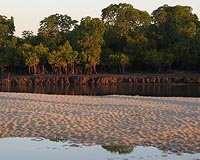 |
New Orleans, Louisiana (AFP) May 9, 2010 Engineers mulled options Sunday after the first try to cap a ruptured pipe gushing oil into the Gulf of Mexico failed when ice crystals clogged a containment dome. Officials said they have not yet given up hope of capping the leaks some 5,000 feet below the surface which are hemorrhaging an estimated 210,000 barrels a day. But they cautioned it will likely be several days before a solution is found. "I wouldn't say it's failed yet," said Doug Suttles, chief operating officer for British energy giant BP, which is responsible for the cleanup. "What we attempted to do last night didn't work because these hydrates plugged up the top of the dome." Clearing out the slushy crystals is easy -- the 100-ton (90-tonne) chamber just has to be raised to warmer levels, Suttles told reporters. Keeping the crystals out so that a pipe can be lowered into the dome to suck the oil to a waiting barge is another matter. The engineers are looking at ways to heat the frigid water in the dome, among other options, and have moved the concrete and steel box to rest on the seabed some 650 feet (200 meters) away while they evaluate their options. BP has already begun drilling relief wells to stem the flow, but it will take about three months for them to be operational. It is also considering other temporary measures like trying to plug the leaks by injecting ground-up material in a "junk shot," but Suttles said BP cannot proceed until it is sure that it "won't make the situation worse." The BP official said his company had anticipated encountering hydrates, but had not expected them to be as significant a problem. The dome had been expected to be operational on Monday and to collect about 85 percent of the leaking crude by funneling it up to a barge on the surface. An estimated 3.5 million gallons of oil has formed a slick the size of a small country which threatens the fragile coastal wetlands of Louisiana and the beaches of Mississippi, Alabama and Florida. Favorable winds have kept the bulk of the oil from reaching shore since the BP-leased Deepwater Horizon sank some 50 miles (80 km) southeast of Venice, Louisiana on April 22, two days after an explosion that killed 11 workers. But the Coast Guard reported that tar balls were beginning to wash up on Alabama's Dauphin Island, south of Mobile Bay. If the black gobs that are being analyzed prove to be oil, it would be the eastern-most landfall from the BP oil slick. However, officials closed off the western half of the island to residents last week as part of the region's effort to prepare for the oil's arrival. With a thin sheen of oil now lapping Louisiana's coastal islands, local leaders begged for more boom to protect vulnerable coastal wetlands and wildlife preserves, as well as multi billion-dollar fishing and tourism industries. "It'll be so much harder to clean up this oil if it gets into the marshes," said Governor Bobby Jindal. The US Coast Guard, which is overseeing the recovery efforts, cautioned that resources must be used "strategically." "There's not enough to completely boom off every piece of coastline for all four (gulf) states," Coast Guard Petty Officer David Mosley told AFP. "That's hundreds and hundreds of miles." Fears are growing that the disaster is already impacting sea life in a region home to vital spawning grounds for fish, shrimp and crabs and a major migratory stop for rare birds. "It's going to destroy the industry -- it will never recover if the oil gets into the marshlands," said Cliff LeBoef, whose Louisiana oyster beds are only now recovering from the devastation of Hurricane Katrina in 2005. Beachfront towns across the coast are already suffering from cancellations as fears of an oil slick washes away tourists, as are charter boat captains who make a living catering to sports fishermen. Rough seas last week hampered efforts to skim the oil from the sea with boats and controlled burns, but calmer waters have brought the battle back to the Gulf. Some 270 vessels manned by the US Coast Guard and local fishermen have laid out more than 829,000 of feet of boom and more than 1.9 million gallons of an oil-water mix have been recovered. Officials are also spraying chemical dispersants over the slick to break it up, which produce a similar effect to dish washing liquid. "It's really designed to break down the oil," said Bob Perciasepe, deputy administrator of the Environmental Protection Agency (EPA). "It does not make the oil disappear but it makes it into smaller and smaller particles that makes easier over the long haul to be biodegradable instead of big... really, oily globs."
Share This Article With Planet Earth
Related Links Powering The World in the 21st Century at Energy-Daily.com
 Oil spill could ravage precious Gulf Coast mangroves
Oil spill could ravage precious Gulf Coast mangrovesParis (AFP) May 9, 2010 The BP oil slick menacing the US Gulf Coast poses a direct threat to vast expanses of mangrove forest critical to many of the region's fragile ecosystems, experts say. Some 2,000 square kilometres (800 square miles) of US coastal mangrove habitat are concentrated in three states most threatened by the estimated 5,000 barrels-a-day of crude oozing into the Gulf: Louisiana, Texas and the south ... read more |
|
| The content herein, unless otherwise known to be public domain, are Copyright 1995-2010 - SpaceDaily. AFP and UPI Wire Stories are copyright Agence France-Presse and United Press International. ESA Portal Reports are copyright European Space Agency. All NASA sourced material is public domain. Additional copyrights may apply in whole or part to other bona fide parties. Advertising does not imply endorsement,agreement or approval of any opinions, statements or information provided by SpaceDaily on any Web page published or hosted by SpaceDaily. Privacy Statement |